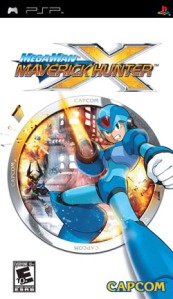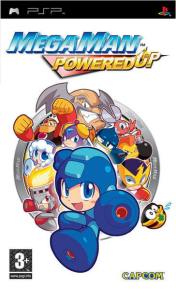Generational Gap
I’ve always been an X fan myself. This is perhaps simply because I almost completely missed out on the NES era. I wasn’t really into gaming as much at the time, and a $10/week allowance was just not enough to buy games. I think the only NES game I ever owned was Super Mario Bros. 3, and I never beat it. Damn, what did I do for the first ten years of my life?
Needless to say, I hopped on board for the SNES era (thanks, Blockbuster!) Mega Man X was my first experience with the games, and I loved it. I did play through the original Mega Mans eventually, and I even rented Mega Man 7 one time, but they just didn’t stick with me. Broadly, the same holds true for these remakes of the original games in both series.
Of the two, Powered Up has clearly had more work done. The platforming isn’t as horrible as I remember, either. I distinctly remember some nasty disappearing-block screens in the original Ice Man level, but no such thing is present here. Even nicer, you can pick Easy mode, which helpfully places helper blocks over some of the trickier platforms. This is not how Mega Man is supposed to be played, I suppose, but that is part of why I enjoy Mega Man X better and always will. The focus there (and in the remake) is on the action, and believe it or not, I play Mega Man games for the action. I always will.
Mega Man 9 is now out, and you can scarcely read anything about it without hearing about its extreme difficulty. The series is evidently known – and loved – for its difficulty, and it baffles me. Any action game I play that forces me to replay large sections of levels after dying at the end does nothing more than infuriate me. Forcing players to replay content is, I would argue, a cheap way of creating challenge and gameplay time. Most of the games in the Mega Man series, Powered Up and 9 included, are guilty of this and praised for it by people who would otherwise complain about it. “When you [die], you’d better prepare to retread a lot of ground, as each stage comes equipped with only two checkpoints: one at the halfway mark and one at the boss’s antechamber” (Ryan Scott, Mega Man 9 Review, 1up.com).
Scott, in his article, does not hide the reason for his pass on the game’s difficulty nostalgia. 9 recreates the “difficulty” of the originals as a tribute. I understand that. What baffles me is that gameplay involving instant-kill fire pillars (requiring nothing less than trial and error to pass) requires tribute at all. Honestly, I can attribute Mega Man’s popularity to nothing other than $10/week allowances. Kids bought Mega Man 2, and that was it. You couldn’t return it, and you either played the hell out of it and learned to love it or you doped around for the next six weeks or Christmas, whichever came first, when you could get something else. Love for Mega Man is a sort of fetishistic, masochistic dream.
Of course, these same people deride the X series, and it’s easy to see why. After you’ve learned to love it when your girlfriend locks you up for hours in her basement, it’s hard to love a girl who just wants some nice, passionate love making on the Serta. So call me a romantic. I like the dark overtones, the simplistic (relatively speaking) platforming, and the action. I like replaying the levels to find every secret and beating the bosses. I even like the story here and there, as much like cheap ’90’s anime as it is.
I want to like Powered Up. It is a clear labor of love, compared to the X version, which feels like a simple fulfillment of a business contract. The addition of an Easy mode is refreshing and, to my knowledge, doesn’t punish the player for its use either. The horrible voice acting certainly fits Powered Up better; it seems whimsical and funny, rather than painfully over-dramatic. And the changes made to Powered Up’s levels are entirely, in my view, excellent; the few changes that X makes seem baffling and irritating, particularly the way Zero dies. In the original, Zero’s death was, for a SNES game, a cinematically moving moment – at least to my 12-year old eyes. Now, his death just falls flat.
It is hard to fault Powered Up for having difficult platforming sections when the original did. It’s also hard to argue with the sheer amount of content they put into the game. The addition of 10 challenge courses for every character (Mega Man and the robot bosses) is an amazing favor. Typically, the stages involve challenging platforming, but they are short enough to get away with it. In addition, the stages require you to take advantage of each character’s strengths. That makes the challenge intriguing, if off-putting after your 20th try on the same stage.
Maverick Hunter, on the other hand, sports very little change – aside from graphical – and the ability to play as Vile through the same stages is just not that fascinating. Though I like X’s gameplay more, and always will, I have to submit that Powered Up is the better remake – and should stand as the standard for every remake of old games when it comes to depth and quality.
Final Score: A- (Powered) / B- (Maverick)


Leave a comment